"The RMS Titanic and its Times: When Accountants Ruled the Waves"
Elias Kline Memorial Lecture
69th Shock & Vibration Symposium
Roy Brander, P.Eng.
Introduction
Thank you and good morning. I owe this honour to the combination
of 13 years interest in the Titanic, and a life-long interest
in puzzling over why so many decisions about public safety are made so
irrationally. In 1995, I read the wonderful book "The Night Lives
On", by celebrated Titanic historian Walter Lord, author of "A Night to
Remember". In it, he made the case for Titanic having been designed
much less safely than many ships of previous decades, because the vicious
competition between steamship lines had caused them to cut and chip away
at standard safety features. I wrote a web essay on risk management
philosophy in general, giving Titanic as the specific example. After
the movie came out last winter, I began to receive thousands of hits and
a lot of very kind notice... and here I am. I still make no claim
to be a professional historian or risk management expert, but I think I've
found you some food for thought.
Ice drawing
First, lets review Titanic's own case, for both of you who have not
seen the movie. Titanic brushed the iceberg with her starboard bow
so that it ground against the hull plates. She was not gashed open,
but the pressure on the plates buckled them and popped rivets, opening
the hull to a myriad of small leaks at the seams. Yes, the steel was brittle
by today's standards - but it passed all tests required at the time.
They only tested for slow elongation and bending - and with the metal at
80 degrees fahrenheit, at that. The total area opened was only some 12
square feet - but, crucially, it was continued over 250 feet of the hull.
Flood drawing
Twelve square feet meant more flooding than the pumps could handle - a
ton every five seconds. It was spread over the first five watertight
compartments, plus leakage into the sixth up from the floor plates.
Had it only been the first four compartments, they would have filled up
to the waterline and it would have stopped there.
After the first two, the bulkheads only went up to "E" deck (highlighted
by the dark line), a just 10' above the waterline. Filling
even the first five compartments meant that the bow would be depressed
enough for the fifth bulkhead to go below the waterline, spilling water
into the sixth compartment, then the seventh, and so on. Like many
engineering disasters, their failure was not of calculation, but of imagination
- they just didn't imagine this failure mode.

(blue area is that below normal waterline when loaded)
Marked up from a drawing in "The Shipbuilder" magazine in 1911
The red lines show how much higher these bulkheads were taken in the
sister ships, Olympic and Britannic - after the disaster. It wasn't
so much the cost of building them that was a problem - it was that they
made movement about the ship more difficult for passengers and stewards alike
- and bad service is always bad for business.
Period Cutaway Illustration
This period illustration shows the water level rising over the watertight
bulkheads and spilling backwards, as people flee towards higher decks.
The third class passengers were not kept back as any kind of policy to
keep them from the boats; there was simply no policy at all - some were
escorted right up, others told to wait, as lower classes always waited
for everything while upper classes went first. All 32 of the engineering
staff, right down to the Assistant Sixth Engineer and the Extra Assistant
Fourth Engineer - Refrigeration, remained at their posts in the lower decks,
desperately keeping the lights and pumps running until the last few minutes.
Not one survived. Neither did any of the nine-man "guarantee team" of engineers
and tradesmen provided by the Harland & Wolff shipyards to assist with
the shakedown. Unlike the eight-man band, these 41 engineering staff were
seldom immortalized as heroes in newspapers or the various movies.
Sepia Thomas Andrews Photograph
The head of the guarantee team was the Managing Director of Harland
& Wolff, Thomas Andrews. Andrews had lived shipbuilding since he was
16. A completely dedicated engineer he often arrived at the yard
at 4 AM. He didn't read novels or even newspapers, just devoted all his
time to mathematics and his profession. He was something of a hero
to the 17,000 Irishmen of the shipyard despite his upper-class credentials
as the nephew of Lord Pirrie, owner of Harland & Wolff. Workers told
stories of him in his twenties saving men from falls, dodging hot rivets
and laughing about it, and taking dangerous construction jobs rather than
let a married man do them. (He was 39 with a wife and two-year-old daughter
when he boarded the Titanic.)
H&W Design Department
Andrews was promoted from running Harland & Wolff's Design Department,
shown here. He is described as Titanic's builder, and the term is
no exaggeration. He had personally done the overall design, not only
for her structure and mechanical, but even much the interior decor and
furnishings; and then went on to manage the whole yard as she was built.
Titanic was his creation more than anyone else's.
Great Eastern at Launch
Now let's flash backwards 54 years. The "Great Eastern" was the
last creation of Isambard Kingdom Brunel, England's most celebrated engineer
of nineteenth century - or perhaps any other. The Great Eastern is
shown here during her arduous launching from her birthplace by the Thames,
there being no dry-dock in 1858 that could have held her. At 700
feet long and over 25,000 tons, her length and displacement were not exceeded
for almost 50 years. At the time, she was six times the size of the
next biggest ship ever built.
The Great Eastern; showing paddle-wheels & winch
This view shows her enormous paddle-wheels - she also had screw propulsion
from different engines, and sails, making her almost immune to immobilization
from mechanical failure. In the foreground is the huge chain link
winch being used to launch her broadside into the Thames.
Brunel in front of the chain links
Isambard Kingdom Brunel, posing in front of the 60 pound chain links
of the winch. He was a hero, not to one company, but a whole nation.
All England resounded with his praises. Building the Great Eastern,
and two previous record breaking ships that had advanced the shipbuilding
art in their time, was only one engineering field that he revolutionized.
He would have been wealthy and famous for his other accomplishments - tunnels,
railroads...
Bristol Railroad Station
... and the some of the most beloved of England's huge railroad stations,
like this one in Bristol.
Royal Albert Bridge
And also, of course, the large suspension bridges that the new iron
technologies had made practical. Some still survive, like the Royal
Albert Bridge shown here under construction. He was, quite simply, a star.
The Economist, May 18th, 1998, pg 91
The photograph of him in front of the Great Eastern appeared again
in "The Economist" magazine just last May in an article asking why engineers
are no longer considered heroes and stars - It asks, "Why are architects
celebrated and engineers anonymous?"
Currier and Ives Lithograph of the Great Eastern
When he designed the Great Eastern, the investors trusted him almost
absolutely. He got a nearly every feature he desired. She was
considered the wonder of the age, and thousands of these Currier &
Ives lithographs were sold before she was even launched.
Great Eastern sections and model
(from "The Great Iron Ship" by James Dugan)
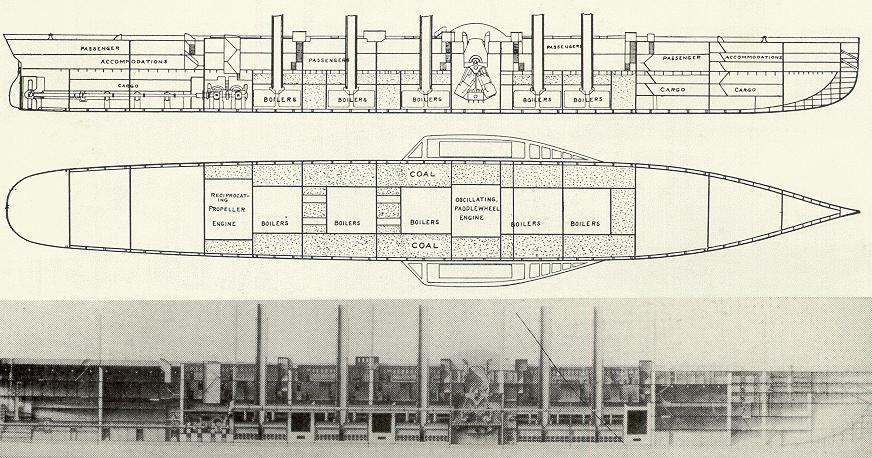
To quell fears about sailing in such a monster, Brunel was obsessive
in designing her for safety. The Great Eastern, like the Titanic,
had fifteen transverse bulkheads. Hers, however, went a full 30'
above the water line, right to the top deck in the fore and aft.
In the engine rooms, they were lower, but the engines were further protected
by longitudinal bulkheads on either side. The middle deck was also
watertight, further subdividing the compartments into some 50 in all.
And to even get this far, a breach had to first go through a double hull
- the second hull two feet inside the outer. Military strategists
and nuclear plant designers speak of "defense in depth". This was
defense in depth against flooding.
Cofferdam section from 1917 Scientific American
(from "The Great Iron Ship" by James Dugan)
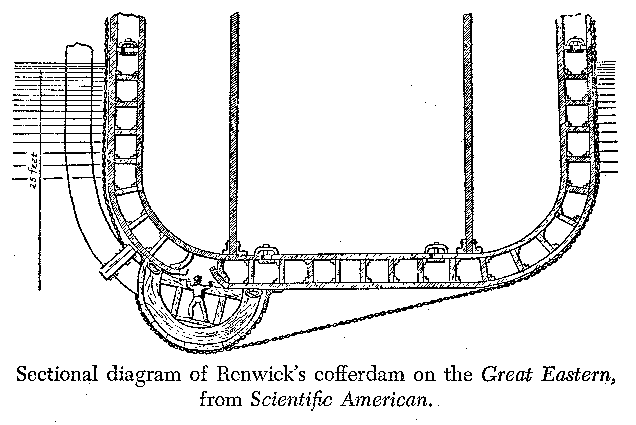
In late August of 1862, the design was put to the test a day out
of her U.S. port at Flushing
Bay, New York. There was a grinding noise and a slight heel to port
- but she made Flushing a few hours later without incident, listing a little
to starboard. The outer hull had been ripped open by rock spire still
called Great Eastern Rock on the charts. The breach was 83 feet long
by 9 wide, perhaps 60 times the area of Titanic's damage - but the inner
hull was unhurt and the inside was dry. This diagram from a 1917
article in the Scientific American shows her being repaired using a carved
wooden cofferdam clamped to her side, an invention of another great engineer,
Professor James Renwick of Columbia University.
With few exceptions, later liners cut these features. The double
hull was extremely expensive and ate up space; longitudinal bulkheads made
it difficult for stokers to work, and, as mentioned, watertight decks and
bulkheads made it difficult to get around the ship.
And the competitive pressures were intense! This table comes
from the enthralling book, "Cunard and the North Atlantic: a History of
Shipping and Financial Management". Here are nautical tales to stir
the blood, me hearties! The triumph of 1889, when the Cunard line
made over 200,000 pounds; the breathtaking suspense of 1884 when they barely
broke even; and the heartbreak of 94-95, when they lost big time, two years
running.
| Cunard Line Profits, 1880-1899 (£
, 1000's) |
| Year |
Non-operating Income |
Non-operating Expenditure |
Net Non-operating profit/loss |
Total Net Income |
| 1880 |
10 |
- |
10 |
133 |
| 1881 |
21 |
- |
21 |
93 |
| 1882 |
18 |
- |
18 |
129 |
| 1883 |
8 |
- |
8 |
53 |
| 1884 |
15 |
15 |
- |
2 |
| 1885 |
- |
27 |
-27 |
25 |
| 1886 |
1 |
22 |
-21 |
23 |
| 1887 |
3 |
13 |
-10 |
119 |
| 1888 |
6 |
2 |
4 |
177 |
| 1889 |
13 |
- |
13 |
219 |
| 1890 |
24 |
- |
24 |
120 |
| 1891 |
32 |
- |
32 |
96 |
| 1892 |
38 |
- |
38 |
49 |
| 1893 |
29 |
- |
29 |
46 |
| 1894 |
5 |
1 |
4 |
-84 |
| 1895 |
5 |
2 |
3 |
-38 |
| 1896 |
5 |
- |
5 |
65 |
| 1897 |
8 |
- |
8 |
55 |
| 1898 |
12 |
- |
12 |
89 |
| 1899 |
15 |
- |
15 |
122 |
I should not make fun - cash flow was the life-blood that made the
shipbuilding possible. This chart shows the outlines of the ships
that Cunard developed from 1840 to 1900 - a more than linear growth in
length, and more than a cube growth in displacement.
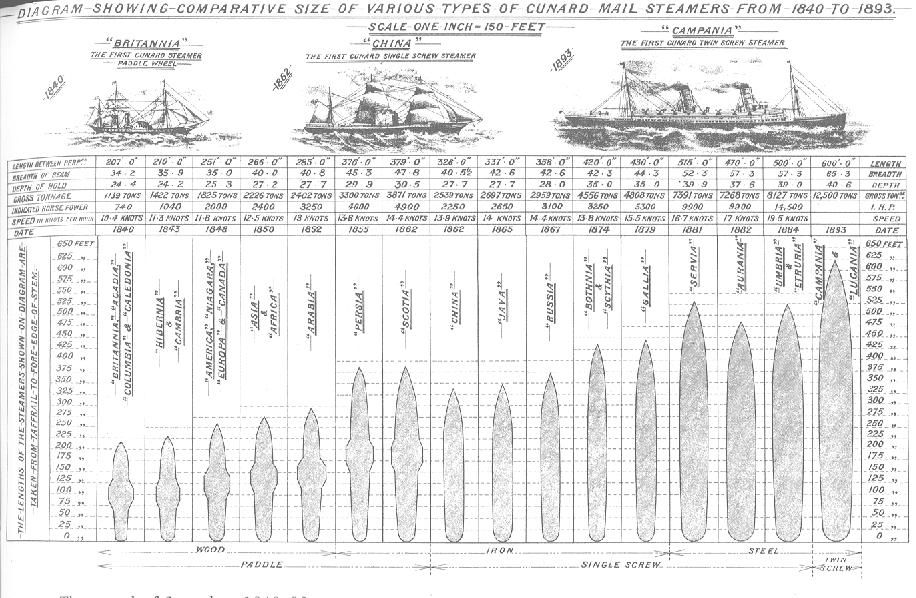
(as shown in "The Liners" by Terry Coleman, pg 35)
Cunard's sum displacement
for the line went from 8000 tons to 136,000 during this period. And all
the while speed was increasing. The technological and cost curves
were nearly exponential,
like the computer industry today, as they went
from wood to iron to steel, and paddle-wheels to single-screws to double.
And you had to advance and present the public with the latest, biggest
product or lose all market share. They were perpetually a few
percent of their income away from red ink - because when they did make
big profits they mostly had to be reinvested.
Puck Magazine Cover (from Coleman's "The Liners" pg 53)
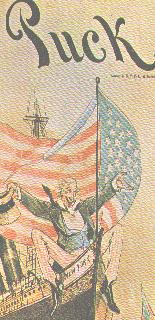 And the competition was not just between companies, but countries,
which often subsidized their lines. Cunard itself had a subsidy for
carrying the mail. In the 1890's, when Britain's Inman line went
broke, she was purchased by Americans who cut a subsidy deal with Congress.
President Harrison himself raised the Stars & Stripes on one of
the two Inman flagships, the City of Paris.
And the competition was not just between companies, but countries,
which often subsidized their lines. Cunard itself had a subsidy for
carrying the mail. In the 1890's, when Britain's Inman line went
broke, she was purchased by Americans who cut a subsidy deal with Congress.
President Harrison himself raised the Stars & Stripes on one of
the two Inman flagships, the City of Paris.
Puck Magazine Detail
As this detail from the cover of the popular Puck magazine says, "it
came high, but we had to have it"... it was a matter of national pride
- and strategy -
to get America back in the Merchant Marine game with the high-tech British.
America had been a major commercial shipbuilder in the days of wood and sail.
When steamers had obsoleted the technology, America had been striken by
the Civil War and unable to effectively play catch-up with the world-leading
British. It was commercially and, in the end, militarily important to
get back in the game. The competition was friendly in a sense, deadly
earnest in another. Sometimes commerce, like war, is an extension of
politics by other means.
Paris & New York Illustration (from "The Liners" pg. 37)
I myself prefer this illustration not only showing the flag on both
Inmans twin steamers, the City of New York, and the City of Paris...
Paris & New York Illustration Detail
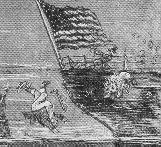 ... but shows the British Lion and John Bull (the English equivalent
of John Q. Public) being thrown overboard. As I said, it was a cutthroat
business. The international competition gave the shipbuilders
the same cry to the government about regulations that is still heard today:
that costly regulation would cause them to lose business to other countries,
in this case Germans and the French.
... but shows the British Lion and John Bull (the English equivalent
of John Q. Public) being thrown overboard. As I said, it was a cutthroat
business. The international competition gave the shipbuilders
the same cry to the government about regulations that is still heard today:
that costly regulation would cause them to lose business to other countries,
in this case Germans and the French.
Here's a ledger the accountants didn't keep.
|
| Yr. |
Ship |
Line |
Deaths |
| 1854 |
Arctic |
Collins |
278 |
| 1856 |
Pacific |
Collins |
186
|
| 1857 |
Tempest |
Anchor |
150
|
| 1868 |
Hibernia |
Anchor |
66
|
| 1870 |
Cambria |
Anchor |
190
|
| 1873 |
Ismalia |
Anchor |
52
|
| 1873 |
Atlantic |
White Star |
546
|
| 1895 |
Elbe |
North German Lloyd |
303
|
| 1898 |
La Bourgogne |
French |
549
|
| 1904 |
Norge |
United Steamship Co. |
701
|
| 1907 |
Berlin |
North German Lloyd |
140
|
| 1909 |
Republic (&Florida) |
White Star |
4
|
|
|
|
3165
|
I've listed only the major deaths on Atlantic lines, to capital ships,
or we'd be here all day. The question of safety of design was really
the least of it - a lot of these ships were lost in disasters like
going onto rocks, that no design would have survived. Speed was a
major competitive advantage, and also a matter of great pride, so they
often went at full speed in bad weather. Everyone wanted to fly the
coveted Blue Riband, signifying the current record holder for the crossing.
You will note that the Cunard line is not mentioned here. They are
the good guys in this story: Samuel Cunard and all his successors were
adamant that speed was important, but could be sacrificed to safety.
They were the classic Victorian British: stodgy, careful, conservative.
The line survives to this day, and has yet to lose a passenger to a wreck
in peacetime.
An American line run by Edward Knight Collins in the 1850's was the
opposite. They briefly seized half of Cunard's business by beating
them with glamour and speed. They drove their ships near to breakdown,
wasting fuel to cut half a day off the trip. Newspapers lionized
them and made fun of stodgy old Cunard. In 1854, the Collins steamer
Arctic had a collision running at full speed in the fog, and only 52 of
330 on board survived. Among the dead were Collins' wife, son and
daughter.
Undeterred, he bought another wooden paddle steamer the next year.
In 1856, the Pacific was racing the new, faster Cunard Persia to Liverpool.
The Persia was the first iron mail steamer, with two longitudinal bulkheads
and seven transverse. She limped in three days late with the bow stove
in, having hit an iceberg. The Collins Pacific, presumed to have
done the same, was never seen again. The newspapers turned against
Collins, the line lost its mail subsidy from Congress, and was sold to
creditors.
The loss of the White Star Atlantic, which stranded and broke up in
sight of land forty years before the Titanic with the loss of over 500
lives, is an echo of the errors of the Titanic: the inquiry said that they
ran at full speed upon well known rocks, at night, in fine weather.
I also snuck the loss of the White Star Republic onto the list by counting
the four lives lost on the Italian ship, the Florida, which collided with
her. While all the passengers were saved, the point is that they
were going at full speed in heavy fog, and could not avoid collision even
though they heard each other's fog whistles.
White Star was as good a line as almost any of them; all of them were
culpable of such behaviour. Even Cunard's unbroken record is acknowledged
to be partly luck.
There were some ships where the design worked; the Guion Line
"Arizona"  hit
an iceberg going 15 knots in heavy fog in 1879, and it telescoped 25 feet
of her bow. But she had 7 transverse bulkheads that went all the
way to the top deck and the collision bulkhead held, letting them make
Halifax. It increased the public perception that iron liners were
unsinkable, increasing industry traffic in general, and certainly the Arizona's
ticket sales in particular.
hit
an iceberg going 15 knots in heavy fog in 1879, and it telescoped 25 feet
of her bow. But she had 7 transverse bulkheads that went all the
way to the top deck and the collision bulkhead held, letting them make
Halifax. It increased the public perception that iron liners were
unsinkable, increasing industry traffic in general, and certainly the Arizona's
ticket sales in particular.
Servia illustration
Cunard's Servia, in 1881, actually had a double hull, the only other
mention of such in a civilian ship I could find in the era. There
were also 12 transverse bulkheads, 8 of them all the way to the top. The
Servia was also the first steel ship, which saved so much weight that the
extra cost was well repaid in fuel saved. I think the pattern here
is that when engineers introduced a great new technology that saved money,
or brought in business, they could get their way with design features for
a while. Then all the lines would get the technology, and competition would
bring the cuts again.
City of Paris/New York

Another example would be the aforementioned "City of Paris" and "City
of New York" twins of the Inman line that the Americans bought. They
were the first twin-screw ships, faster, bigger, more luxurious and very
lucrative. The twin screws allowed a single longitudinal bulkhead
down the middle, between the engine rooms; and the transverse bulkheads
went 18 feet above the water line. So there were some more conservatively
designed ships just a decade before the Titanic.
Lifeboat Advertisement
Naval Architects argue about whether the extra bulkheads are really
safer, but you can't argue about the lifeboats. Lifeboats are the
final layer of defense in depth. Without lifeboats, you really have all
your eggs in one basket - the worst nightmare of risk management. The British
Board of Trade Rules for supplying them were based on cubic feet of lifeboat
space per ton of ship... not on the number of people aboard. By these
antiquated regulations, Titanic had more lifeboats than she needed.
But the Board's Advisory Committee was dominated by ship owners, who didn't
want the expense and especially not the deck space used up.
The Managing Director of Harland & Wolff before Andrews, while Titanic
was still being designed, was Alexander Carlisle. He ordered these davits
that could have held four boats each - but he suggested only faintly and
timidly that even two boats per davit actually be supplied. Bruce
Ismay of White Star didn't take the hint, and Carlisle, not wanting to
offend the biggest customer, didn't press it.
The lack of lifeboats was exacerbated by poor procedure. There
had been only one lifeboat drill, in dock, with one boat full of the ship's
best seamen. When the time came, there was confusion about how many
they could hold and how to lower them.
Unbelievably, Cunard had not learned from White Star's Titanic when the
Cunard Lusitania was torpedoed three years later by a German U-boat.
The passengers had asked the Captain twice to hold a lifeboat drill for
all of them to practice. He refused, holding only a one-boat drill with
his own crew. When they had just 18 minutes to save themselves after
the explosions...
They had another mob scene trying to load boats, they dropped boats into
the sea, they lowered boats onto other boats, and they saved a total of
38% of the almost 2000 people aboard. Three months later, the White
Star Arabic was torpedoed only 50 miles from the same spot with 500 aboard.
Over 90% survived, though she sank in only nine minutes. Preparation
makes all the difference.
Let's turn to the aftermath and the outrage that brought about change.
Even some very conservative and popular Titanic histories openly say that
Lord Mersey's British Inquiry was a whitewash, blaming the disaster on
unique conditions and exonerating all involved. This exchange is
notable in that a witness correctly says that an unsinkable ship is impossible.
But then they make a logical leap from that to actually laughing at the
notion of a double hull, as if it were absurd to even strive for reduced
sinkability.
MERSEY: 'I suppose it is impossible to make a ship
unsinkable and at the same time a commercial success? You can, of course,
conceive of an iron box riveted so that nobody can get into it, but that
would not do as a ship... I suppose that some people would say you should
carry the double bottom up to the upper deck?' [Laughter]
Has an unsinkable ship ever been constructed?
THE ATTORNEY GENERAL: They are sometimes called unsinkable,
but that means under conditions which comprise every form of disaster so
far known.
(As quoted in "The Liners", by Terry Coleman, pg 83)
Six months later, the idea wasn't so funny. The sister ship Olympic
was in dry-dock being fitted with an inner skin and bulkheads that went
20 feet higher. The price was a quarter again of her original construction
cost. But competitive positions between lines suffered little,
as everybody was suddenly spending on these previously unaffordable features.
Other ships in construction in England and Germany went to double hulls
and high bulkheads in mid-construction.
New York Herald, April 18th, 1912, p. 5

Why? The newspapers had gone ballistic and stayed there.
Carpathia had barely returned with the survivors when the New York Herald
was publishing quotes from Admirals and the Secretary of the Navy about
greed being responsible for the disaster; and there was a drumbeat of a
calls for reforms: lifeboats...
New York Herald, April 18th, 1912, pg. 6

... ice patrols, safer southern routes, new wireless procedures.
And most of all, for ships to slow down, especially in fog.
New York Globe, April 19th, Front page
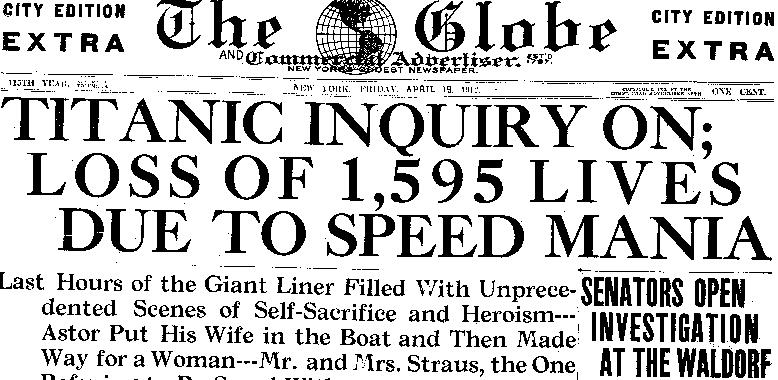
But the Herald was one of the more restrained newspapers; the New York
Globe broke out the war type. No other disaster has ever so inflamed
public opinion on safety standards issues.
Any doubts I might have had about the importance of this were set to
rest by the introduction to the chapter on watertight subdivision in the
classic text "Principles of Naval Architecture", by James Robertson.
A committee of engineers had recommended new subdivision rules in 1891.
They were ignored until the loss of the Elbe in 1897 with 303 lives, and
then there was only partial compliance. Robertson points out that it was
only the Titanic that caused a convention on safety in 1913 where all nations
agreed to the same method.
There was another "Safety Of Life At Sea" (SOLAS) conference in 1929,
But the U.S. only ratified it in 1936 after the loss of the Mohawk to collision,
and the Morro Castle by fire. Robertson puts it in a nutshell when
he says that a 1948 convention had only slightly stricter requirements
because it "did not have behind it the compelling force of recent sea tragedies
and aroused public opinion". He says it took the shocking
loss of the Andrea Doria in 1956 to force a 1960 convention that brought
about subdivision formulae and other safety standards close to those used
today.
The week in 1995 I wrote the original essay, thousands of semi-trailers
in Canada were being pulled off the road to have their outer wheels inspected.
Two cars full of people had been killed in two weeks by semi wheels that
had come loose and run wild. It turned out that such things had been
happening every month or two all along; this was just the first time that
several fatalities had happened. As individuals, we may learn from
close shaves and warnings; as a society we only learn from blood.
Oil Tanker Book cover
Thus ends the core of my tale, but I have some interesting asides for
you. A web search on "double hull" not only told me about the Cunard
Servia, but the Oil
Pollution Act of 1990, which mandated double hulls for oil tankers...
one year after the Exxon Valdez tripled the global yearly oil spill average
and caused a hundred-fold increase in media and public attention.
The report
summary on the web mentions that double hulls will increase oil transporation
costs by 10%, which to a ship owner is appalling; but it only increases
oil prices by a tenth of that, or 1%, (and the price of a tank of gas by
a nickel, according to the Coast Guard). After the Valdez, few consumers
are going to begrudge a nickel a tank to cut the chance of a repetition.
Cunard Ad
Which brings me to a related topic: safety can be marketed as a product
like any other and most consumers are happy to pay for it when they are
educated about the risks. Detroit at first fought the addition of
$12 seat belts in cars and hassled Ralph Nader for pushing the issue; after
Volvo and Mercedes made safer designs a premium feature, Detroit began
to change and they now advertise expensive airbags in the same breath as
the CD player. My wife took me out of the loop on the choice of model
for our last car when she heard the '95 Saturn had dual airbags, standard.
Perhaps that's why today, while Cunard lines use their one-line description
space at upscaletours.com
to tout their "ocean liner amenities and yachting ambiance"...
Seabourn Ad
... and Seabourn lines uses their space to advertise their "small,
elegant ships and country-club accommodations"...
Radisson Ad
... the smaller Radisson line specifically mentions a ship with a unique
double hull design.
"Cruise Ship Runs Aground in Florida", Associated Press Feb. 19,1998
I assume they mean that the design is unique, not a double
hull on a cruise ship. It can't a premium feature, since Carnival
Lines are considered the "Wal-Mart" of the industry by their competitors,
and this Carnival Cruise ship avoided a nasty incident because of a double
hull just a few years back. A harbour pilot with a bad safety record and
a drunk driving conviction scraped bottom near Florida. The ship
was cleared to sail on her journey after an inspection by divers showed
only a minor breach of one cell of the outer hull.
RINA Home page
The touchiest thing in risk management is the calculation of cost per
fatality averted. It makes perfect sense to an engineer, but in public
debate, such numbers can always be twisted in any direction. On the
web I found an excellent site at rina.org.uk,
the Royal Institution of Naval Architects. (Thomas Andrews joined it
in 1901) They've sponsored many conferences, including one
on ship survivability.
Ship Survivability Article Summary
Public attention had been drawn by some car ferry disasters just before.
The problem for the engineer is to tackle these fears with his own art,
which involves quantifying things.
The summary
of one paper in those conference proceedings went right to the heart
of the issue - he had calculated the cost per fatality averted for various
different approaches of ship subdivision, so as to recommend which design
to use. This is good engineering and I wish all society thought that
way; but I guarantee you that any politician or top bureaucrat will flee
the room, eyes averted, if he shows them the paper; they'll want deniability
in public debate.
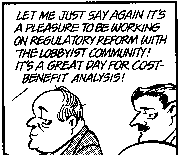 In 1995, Bob
Dole took a walk in this mine field when he led a congressional charge
to hold back certain regulatory efforts, in particular increased scrutiny
of the meat industry. Dole and his allies surely never mentioned
exact figures for the money-cost vs. lifesaving-benefit of the proposed
regulations...
In 1995, Bob
Dole took a walk in this mine field when he led a congressional charge
to hold back certain regulatory efforts, in particular increased scrutiny
of the meat industry. Dole and his allies surely never mentioned
exact figures for the money-cost vs. lifesaving-benefit of the proposed
regulations...
 ... but the
always merciless satire of the Doonesbury comic strip quickly knocked the
issue down to the one unmentionable question: What is a human life worth?
... but the
always merciless satire of the Doonesbury comic strip quickly knocked the
issue down to the one unmentionable question: What is a human life worth?
 Just as the
oil tanker hulls can be viewed as a nickel per tank of gas, you can always
twist these kinds of figures to something that sounds damning if you're
proposing not to spend it.
Just as the
oil tanker hulls can be viewed as a nickel per tank of gas, you can always
twist these kinds of figures to something that sounds damning if you're
proposing not to spend it.
 ... and of course,
Doonesbury always has to take a kick at the tobacco industry. (Which
of course makes all these casualty lists look small.)
... and of course,
Doonesbury always has to take a kick at the tobacco industry. (Which
of course makes all these casualty lists look small.)
(N.B. All four "Doonesbury" images above copyright Garry
Trudeau, 1995. NOT used with permission. I believe
the excerpt counts as "fair use", and in any event, I've deliberately kept
the image quality rotten. Doonesbury has a wonderful
web site to which I commend your attention, and of course the book
"Virtual Doonsbury" from which these are taken.)
I'm a waterworks engineer; this is the last lecture today I'm going
to keep up in. Before this, I did some transportation work, and a
couple of years of structural design. And I think that all engineers face
the same two kinds of problems in the end. The junior ones have to
crank out the most effective design they can, given a cost envelope and
set of standards. The senior ones have to run the calc in reverse, starting
with a design that fits their conscience, to sit on the standards committees,
and push for the cost envelope that will make it possible. Sometimes
they don't, or can't, push hard enough. But to be fair, they do have
a handicap Ė scientific people often donít communicate well with policy
makers, or the general public. They tend to argue with facts,
formulas, simulations, and other kinds of sweet reason. These donít
work well.
What does work well are shameless appeals to emotion - like political
cartoons. Like baby seals covered in oil. And always, always,
casualty lists. Best of all are individual stories of casualties,
to make the deaths real. We only learn from blood.
Thomas Andrews, B&W photo
The individual casualty that haunts me is Thomas Andrews, the builder.
He was seen, just minutes before the final plunge, not by star-crossed
lovers, but by a steward who called at him to come jump for it. Andrews
seemed not to hear, lost in thought. The steward jumped, swam, and
survived. Andrews did not.
Smoking Room, colour drawing
His quick conclusion that the ship was doomed when nobody else would
have believed it had given everyone a head start and undoubtedly saved
many lives. After spending the rest of the evening energetically
encouraging women into lifeboats, he was in the First Class Smoking Room,
perhaps the most expensive per square foot in the ship. Andrews had
done much of the interior design, providing it with heavy mahogany paneling,
carved in place, then inlaid with mother-of-pearl. There were leaded glass
windows, stained glass artworks, and a working fireplace.
Fourth Funnel Area Cutaway
Standing amidst the opulence of the smoking room, just behind the fourth
funnel, beside the equally rich palm court verandah and other rooms on
which no expense had been spared, not where the customers could see it
being spent,
Ballard breakup illustration
... he would still have been dry when Titanic's own weight broke her
back and tore her in two. His creation's end was the last sound he
ever heard.
Smoking Room, photograph
It was this choice of a place to die that makes me like to think that
he had one comforting thought as he waited there. The phenomenon
of disaster bringing higher safety standards of design and procedure was
clear even before his time. Perhaps he realized that the loss of
the Titanic, with all its millionaires and celebrities, would hit the world
like a bombshell, changing standards overnight.
With the Atlantic trade still expanding exponentially, these changes
would almost certainly save hundreds or thousands of lives from many smaller
sinkings averted, losses that each by themselves would have been too small
to bring about change.
So I like to think that he was consoled by some thoughts of all the
lives Titanic's death would save, when the ever-hungry North Atlantic made
the last grand entrance of the evening into that lavish Georgian drawing
room, to take away his sorrow and unbearable shame.
Newspaper for sale
Thank you for you kind attention. I hope the symposium brings
about some improvements in the state of your art.
Copyright, Roy Brander, 1998
I believe all images, save the Doonesbury cartoon as noted above,
to be in the public domain since they pre-date 1919.
A last thought, in honour of Andrews:
"The Hymn of Breaking Strain"
by Rudyard Kipling
Bibliography
(in order that they came to mind)
| The Night Lives On | Walter Lord | 1986 |
|
| A Night to Remember | Walter Lord | 1955 |
|
| Titanic: An Illustrated History | Don Lynch | 1992 |
|
| The Discovery of the Titanic | Robert Ballard | 1987 |
|
| The Great Iron Ship | James Dugan | 1953 |
|
| The Liners | Terry Coleman | 1976 | Dewey
387.243
|
| Fifty Famous Liners | Frank Braynard | 1982 | Dewey
387.2432
|
| Principles of Naval Architecture
| John P. Comstock, ed. | 1967 | LOC
VM 145 C64
|
| Rules for Building and Classing Steel Vessels
| American Bureau of Shipping | 1984 | LOC
VM 287 A44
|
| Passenger Liners of the Western Ocean | Vernon Gibb | 1952 | Dewey
387.243
|
| "Ship" and "Shipbuilding" articles, The Encyclopedia Britannica, 11th edition
| Sir Phillip Watts | 1911 |
|
| The Blue Riband of the North Atlantic | Tom Hughes | 1973 | Dewey
387.243
|
| From Paddle-Wheel to Nuclear Ship | William Avery | 1965
| LOC
VM 315 B33
|
| Metallurgy of the RMS Titanic | Tim Foecke | 1997 | NIST-IR 6118
|
| Exploring the Lusitania | Robert Ballard | 1995 | Dewey 940.4514
|
| Titanic | Leo Marriot | 1997 |
|
| Virtual Doonesbury | Garry Trudeau | 1996 |
|
"The Lessons of Valujet 592"
Atlantic Monthly, March 1998
| William Langewiesche | 1998
|
| The Works of Isambard Kingdom Brunel | Alfred Pugsley, ed | 1976
| 624 BRU W
|
A special prayer of thanks to my great-grandfather, Charles Conybeare,
for leaving a copy of the 1911 Britannica in the family. The 110 fine-print
pages on Ships & Shipbuilding in that never-equalled encyclopedia were
a complete snapshot of the British shipbuilding industry
in the year of the Titanic's construction. This was when the
Britannica always got the definitive expert: Sir Phillip Watts was the
Director of Construction for the Royal Navy. Researchers are advised to
haunt used-book stores; I saw another copy once and have always regretted
not getting it so I'd have a spare in case of fire!
I have lost track of the Web sites to which I'm indebted. Some of them
are already linked from the body of the above text. I'll name just
a couple below, and since they in turn link to many more, the inquisitive
can find their way around as easily as I did.
Encyclopedia Titanica, Philip Hind
The Titanic Historical Society
The Titanic Web Ring, John Ostrowski
Homage to Thomas Andrews, "Builder of the Ship of Dreams"
Ship Losses Around Britain
Where this page comes from:




 And the competition was not just between companies, but countries,
which often subsidized their lines. Cunard itself had a subsidy for
carrying the mail. In the 1890's, when Britain's Inman line went
broke, she was purchased by Americans who cut a subsidy deal with Congress.
President Harrison himself raised the Stars & Stripes on one of
the two Inman flagships, the City of Paris.
And the competition was not just between companies, but countries,
which often subsidized their lines. Cunard itself had a subsidy for
carrying the mail. In the 1890's, when Britain's Inman line went
broke, she was purchased by Americans who cut a subsidy deal with Congress.
President Harrison himself raised the Stars & Stripes on one of
the two Inman flagships, the City of Paris.
 ... but shows the British Lion and John Bull (the English equivalent
of John Q. Public) being thrown overboard. As I said, it was a cutthroat
business. The international competition gave the shipbuilders
the same cry to the government about regulations that is still heard today:
that costly regulation would cause them to lose business to other countries,
in this case Germans and the French.
... but shows the British Lion and John Bull (the English equivalent
of John Q. Public) being thrown overboard. As I said, it was a cutthroat
business. The international competition gave the shipbuilders
the same cry to the government about regulations that is still heard today:
that costly regulation would cause them to lose business to other countries,
in this case Germans and the French. hit
an iceberg going 15 knots in heavy fog in 1879, and it telescoped 25 feet
of her bow. But she had 7 transverse bulkheads that went all the
way to the top deck and the collision bulkhead held, letting them make
Halifax. It increased the public perception that iron liners were
unsinkable, increasing industry traffic in general, and certainly the Arizona's
ticket sales in particular.
hit
an iceberg going 15 knots in heavy fog in 1879, and it telescoped 25 feet
of her bow. But she had 7 transverse bulkheads that went all the
way to the top deck and the collision bulkhead held, letting them make
Halifax. It increased the public perception that iron liners were
unsinkable, increasing industry traffic in general, and certainly the Arizona's
ticket sales in particular.




 In 1995, Bob
Dole took a walk in this mine field when he led a congressional charge
to hold back certain regulatory efforts, in particular increased scrutiny
of the meat industry. Dole and his allies surely never mentioned
exact figures for the money-cost vs. lifesaving-benefit of the proposed
regulations...
In 1995, Bob
Dole took a walk in this mine field when he led a congressional charge
to hold back certain regulatory efforts, in particular increased scrutiny
of the meat industry. Dole and his allies surely never mentioned
exact figures for the money-cost vs. lifesaving-benefit of the proposed
regulations...
 ... but the
always merciless satire of the Doonesbury comic strip quickly knocked the
issue down to the one unmentionable question: What is a human life worth?
... but the
always merciless satire of the Doonesbury comic strip quickly knocked the
issue down to the one unmentionable question: What is a human life worth?
 Just as the
oil tanker hulls can be viewed as a nickel per tank of gas, you can always
twist these kinds of figures to something that sounds damning if you're
proposing not to spend it.
Just as the
oil tanker hulls can be viewed as a nickel per tank of gas, you can always
twist these kinds of figures to something that sounds damning if you're
proposing not to spend it.
 ... and of course,
Doonesbury always has to take a kick at the tobacco industry. (Which
of course makes all these casualty lists look small.)
... and of course,
Doonesbury always has to take a kick at the tobacco industry. (Which
of course makes all these casualty lists look small.)